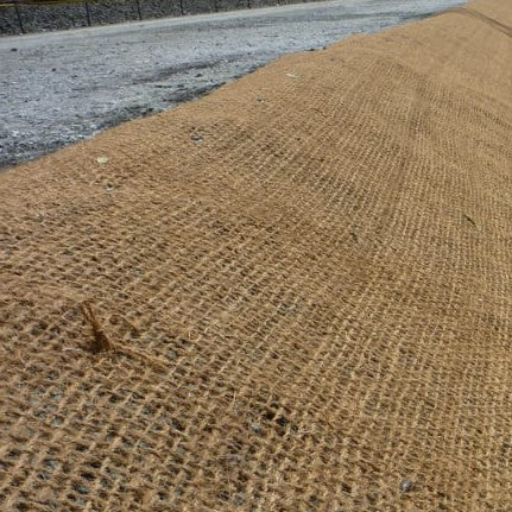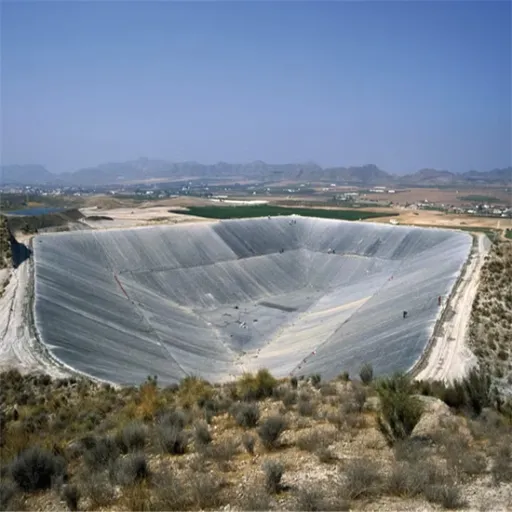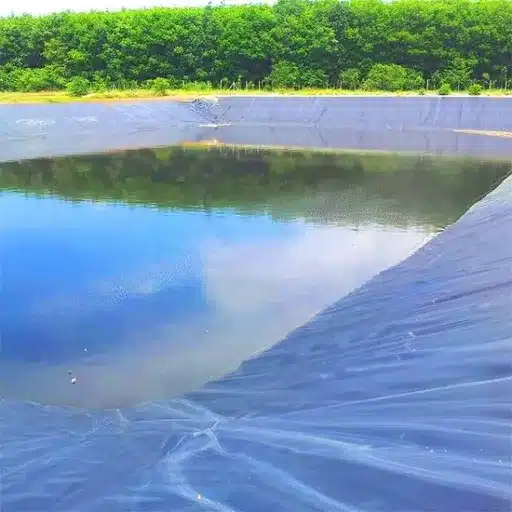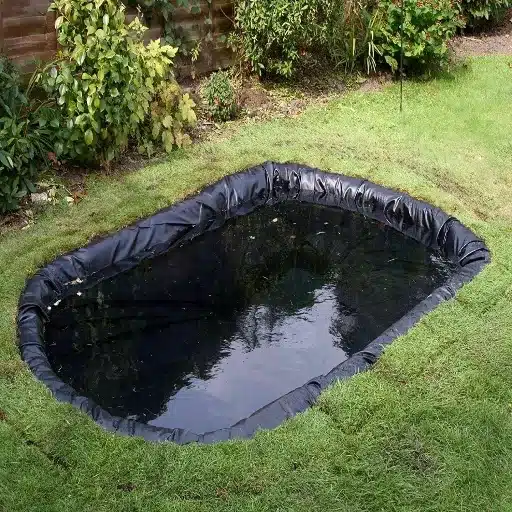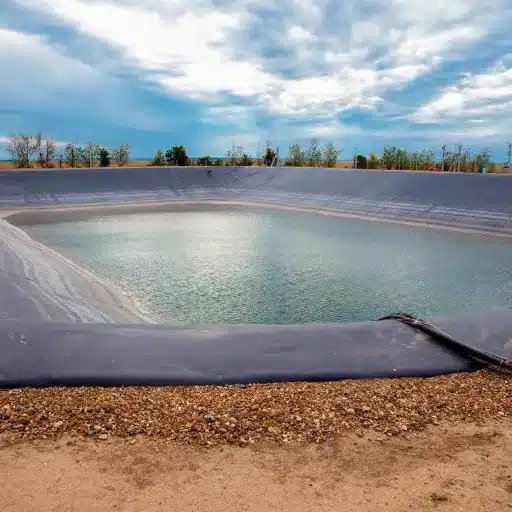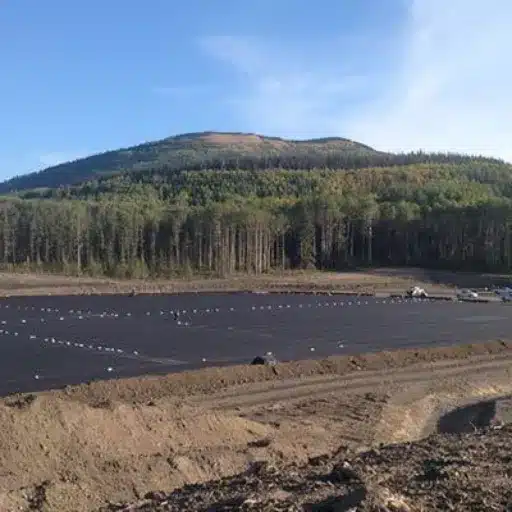When talking sustainable solutions for erosion siltation and conservation, materials like coir and jute are the experts in green choices. Coir matting, widely used as an erosion control blanket, is an environmentally friendly way of protecting landscapes while ensuring support for plant life. An essential tool for large-scale soil degradation control, these natural erosion mats help to conserve vegetation on sloping terrains, riverbanks, and construction sites. In this blog post, we discuss the outstanding benefits of coir and jute erosion control mats, unpack some of their main uses, and find out why they fit perfectly into green projects. Join us as we analyze how these ingenious solutions weigh functionality with sustainability!
Introduction to Coir and Its Uses in Erosion Control
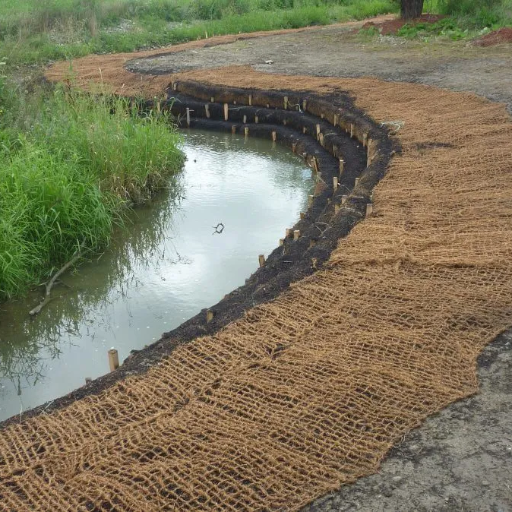
Coir is a natural fiber usually obtained from the husk of coconuts. Considered durable, absorbent of water, and eco-friendly, coir is considered the best erosion control alternative. Coir mats and blankets help to protect soil from runoff and to anchor seeds for optimum growth of vegetation. Such materials are biodegradable so that coir adds nutrients to the soil with no chemical wastes; hence, it is an eco-friendly choice for erosion control projects.
What is Coir?
Coir, also known as coconut fiber, is an organic fiber extracted from coconut husk. These fibers are widely used in a hundred industries, all endowed by nature with strength, versatility, and environmental friendliness. Coir is broadly classified into two types on the basis of the maturity of the fibers.
Brown Coir – Mature coir is coarser and stronger. It is most commonly used for brushes, ropes, mats, and erosion control.
White Coir – The white coir, which is from immature coconuts, is finer and more flexible, and therefore is suitable for spinning into ropes, fishing nets, and mats.
The coir market is presently burgeoning with a spur in application in agriculture, textiles, and construction. For instance, the worldwide coir market size stood at approximately USD 403 million in 2022, and should exhibit a CAGR of roughly 5.8% between 2023 and 2030. Other potent factors affecting this market growth include the rising demand for sustainable and biodegradable alternatives, especially for erosion control and horticultural activities.
Some of the beneficial properties of coir include, due to high lignin content, it has strength to withstand harsh working conditions, it retains moisture while still allowing water drainage, it is naturally resistant to rotting and attacks of pests. These properties come handy in the actual use of the fibers for erosion control, land stabilization, and increased agricultural performance. From coir geotextiles used for slope stabilization to coir pith and peat as amendments to land: this renewable resource is central to environmentally benign and sustainable development.
Importance of Erosion Control
Erosion control is important in conservation of soil from being washed or blown away, prevention of land degradation, and sustainable agriculture. According to reports cited by global soil conservation organizations, some 24 billion tons of fertile soil are lost every year through erosion processes and such loss negatively affects the agricultural productivity and water quality. Coir geotextiles are a reliable way to combat soil erosion, especially on slopes, riverbanks, and construction sites. Coir geotextiles absorb water from 150 to 200% of their weight and have tensile strength ranging between 100 and 120 kN/m, therefore, they act as stabilizers of soil, sprouting vegetation roots furthering stabilization of the area.
Countries such as India, which are well known for coconut fiber production, have used coir-based products in some of the large-scale erosion control projects. For example, information from India Coir Board suggests that geotextiles tackled reclamation of more than 200 hectares of degraded land between 2015 and 2020. Moreover, there have been some recent advances in the development of biodegradable coir products that decompose naturally, enriching the soil with organic matter and diminishing their environmental impact. This reaffirms the growing significance of bolstering classic natural resources with modern research to address environmental predicaments.
An Overview of Coir Erosion Control Products
The coir erosion control products obtained from coconut husks are becoming increasingly popular for their very effective and sustainable approach to combating soil erosion. They are used worldwide for various purposes such as slope stabilization, riverbank protection, and vegetation establishment. Coir products such as geotextiles, logs, and mats marry natural durability with biodegradability and are therefore well-suited for both temporary and permanent erosion control treatments.
Coir geotextiles are particularly valued for their ability to increase soil stability and encourage growth of vegetation. Based on data from the global market, coir geotextiles could cut down on soil erosion by as much as 65% on high-gradient slopes, which makes it a vital tool in land reclamation activities. Meanwhile, coir logs, cylindrical rolls made of tightly bound coir fibers, are frequently used in wetlands and along shorelines to limit sediment movement and further encourage plant root anchorage. These logs, though, are said to last from 2 to 5 years in a natural condition before breaking down into organic matter; hence, they improve soil composition as time passes.
Moreover, the growing importance of the ecological benefits of such products has led to market expansion for coir products. It is estimated from the research reports that the global coir market will hit USD 700 million by 2030 as demand rises for environmentally friendly erosion control products. Countries such as India, Sri Lanka, and the Philippines, which account for about 80 percent of global coir production, continue to innovate while enhancing the product capabilities to meet the rising global demand. Such advancement, on the whole, enhances the position of coir products in combating erosion while encouraging environmental sustainability.
A Variety of Uses for Coir Mats in Controlling Soil Erosion
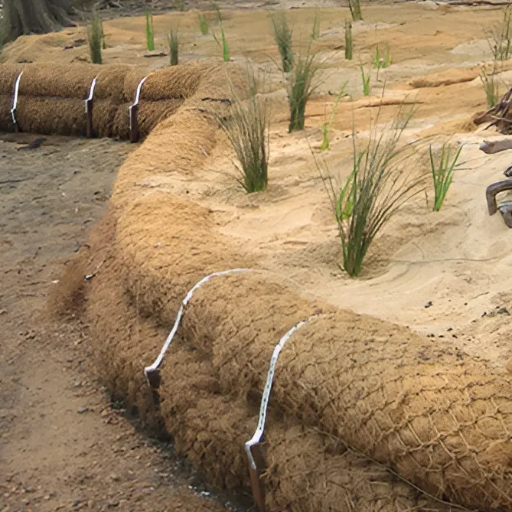
In controlling soil erosion, coir mats have proved to be very effective because the materials are naturally durable and hold the soil in place. They are biodegradable, are environmentally friendly, and provide conditions favorable to vegetation growth by stabilizing the surface while allowing water and nutrients to pass. Therefore, they provide an environmentally sustainable option for erosion control.
Biodegradable and Eco-Friendly
Being made from coconut husks, these mats are completely biodegradable. They will naturally decompose without leaving harmful residues in the environment. This implies that these mats can be placed on sites and, after decomposition, enrich the soil with organic matter. According to studies, natural degradation of coir mats can take 3 to 5 years, enough time to allow plants to grow and shore up the soil.
This means that the advantages of coir mats go beyond the actually erosion control. Coir mats contain no synthetic materials, which would ordinarily contribute to microplastic pollution that is common with artificial erosion solutions. They also exhibit excellent water retention properties, capable of holding about eight times their weight in moisture. This nurtures the growth of plants in dry conditions and reduces excessive use of irrigation.
Now, coir mats have been increasingly used in restoration works at a great scale. For example, they have found use in riverbank protections, slope stabilizations, and reforestation works on a global scale. Choosing coir over synthetic measures would thus put on the map awareness toward sustainable ecological ventures.
Stabilizing Soil and Retaining Water
Coir products such as coir mats and coir logs are crucial for soil stabilization and water retention on account of coir’s inherent strength and absorptive characteristics toward moisture. These products anchor the loose soil very well, thus preventing erosion due to wind or water. This high tensile strength of coir fiber acts as a deterrent to erosion, as it can hold against heavy rainfall and flowing water. Some recent studies claimed erosion in treated sites with coir mats was recorded 30% lesser than in untreated sites, making it very important in erosion control.
With regard to water retention, coir fiber can absorb water up to eight times its weight in water. Such absorbent property is beneficial for drought-ridden areas for extending moisture provision from coir-based materials to the plants, thus reducing the need for irrigation. Conversely, coir blankets have been fully successful in holding water on slopes, facilitating vegetation growth, and at the same time reducing runoff by as much as 25%.
Thus, through the use of coir in little gardens as well as in big restoration works, industries and governments stand a better chance in fighting the tandem effects of soil erosion and water scarcity, making the agricultural and environmental practices sustainable.
Comparison with Alternative Materials like Jute
Coir is compared with jute based on durability, water retention, affordability, eco-friendliness, and strength.
| Parameter | Coir | Jute |
|---|---|---|
| Durability | High | Moderate |
| Water Retention | Excellent | Good |
| Affordability | Moderate | Low |
| Eco-friendliness | Excellent | Excellent |
| Strength | High | Moderate |
Types of Coir Erosion Control Blankets
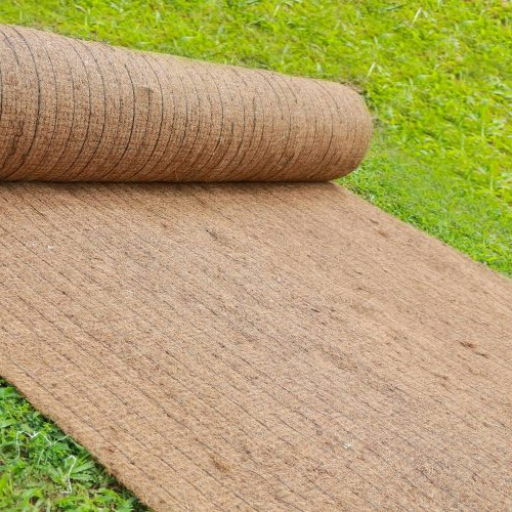
The blankets get their names from the density by which “blanket” disperses into finer weaves. They mainly include the following:
Open Weave Coir Blankets- These tend to be areas with less volume or minimal erosion. Hence, they are light in weight, allowing vegetation to establish rapidly while offering moderate soil support.
High-Density Coir Blankets- These are proper for steeper slopes or areas with high water flow. These offer a lot of strength and a greater thrust towards erosion.
Bio-Netted Coir Blankets- They are made of coir such that include biodegradable netting, thus providing excellent support for the growth of vegetations, which will eventually decompose into soil.
The selection of any one type depends on the nature of the environment and project in need.
700 Gram Coir Mats
700 gram coir mats are very effective in combating soil erosion and facilitating vegetation growth in environmentally sensitive areas. Being made of natural coconut fiber, these mats provide gritty erosion protection while remaining eco-friendly. Ordinarily, their 700 grams per square meter weight means that they maintain adequately for medium-to-steep slopes or those exposed to moderate water flow.
From recent data, 700 gram coir mats provide tensile strengths in the range of 45-65 KN/m, indicating their ability to sustain extreme stress without cracking. Furthermore, these mats being 100% biodegradable disintegrate within 2-3 years. This enables vegetation to set up and helps dynamics of the soil extricate naturally. Moreover, these mats can hold 3 to 5 times their weight in water, which aids in storing moisture for plant growth and also limits water outflow.
Being the prime choice in large-scale landscaping, river restoration projects, and slope stabilization work, the 700 gram coir mats are also in use during roadworks to riverbank stabilization. Its effectiveness has been proven through research that indicated a lowering of surface runoff by nearly 30% and an increase in vegetation establishment in the area by nearly 50% compared to the areas that are left without coir mat cover.
Gram Coir Mats and Their Applications
Since they promote an eco-friendly manufacturing environment, coir mats are therefore also appreciated for their value in ecological preservation and restoration projects. Recent developments and findings lend great support to their big effect on soil erosion control and on fostering vegetation. Coir mats have been effectively proven to serve as biodegradable and eco-friendly protection for slopes and waterways. Studies show that coir mats may stay on natural sites for approximately five years, during which time vegetation develops strong root systems. They are also capable of absorbing large quantities of water, retaining up to five times their weight in water, crucial for moisture retention for plants in dry areas.
They are highly resilient when applied in coastal and riverbank protection projects, resisting water flows of up to 0.75 m/s. Applications also include landscape restoration along roadsides, with reports noting a sediment loss decrease of up to 40 percent in treated cases compared to untreated ones. They allow a broad spectrum of plants to grow, thus ensuring biodiversity and ecosystem stabilization. Also, coir mats have an organic structure, which enables them to play key roles in projects devoted to carbon sequestration.
Custom Solutions for Specific Erosion Control Needs
Erosion control is a diverse area; management strategies must be customized to suit the environment, challenges posed by the site, and particular objectives of the project. Ultimately, a 700gm coir mat achieves the best performance against erosion and assists vegetation growth. These mats can be tailored to suit all sorts of terrains, such as steep slopes, riverbanks, and construction sites, giving them the flexibility needed in erosion mitigation.
Natural fiber-based erosion control products such as coir mats are recorded to reduce soil erosion by at least 50 percent on moderate slopes and greater proportions on ideal management conditions. Combining the strength of coir provided by 700gram mats and its strategic installation can greatly enhance slope stabilization and avoid sediment movements caused by heavy rain or quick flow of water, with the added advantage of reducing runoff and also providing water retention, which are all basic requirements in the establishment of native vegetation.
Moreover, even more studies indicate that vegetation cover in areas treated with customized coir mats could be increased substantially, with a maximum coverage increase of 50% compared to untreated areas. Hence, using biodegradable coir mats is an excellent choice for eco-conscious erosion control, as it ensures that the mats will return to the soil and enrich it without leaving residues. Coir mats blend traditional and new scientific knowledge to be adjusted for particular erosion control needs from a practical standpoint of providing a sustainable and effective solution for soil management.
Technological Advancements in Coir Erosion Control
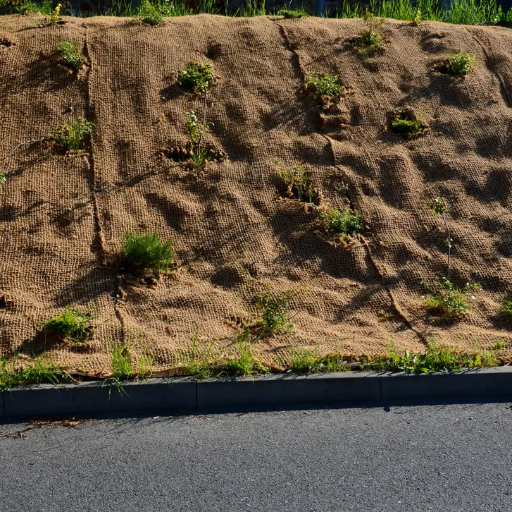
Given the rapid growth of vegetation and the eco-friendly, biodegradable properties of coir mats, this is touted as an ideal means for erosion control. They attempt to present a sustainable solution to soil problems by combining time-tested materials and cutting-edge methods.
Biodegradable Solutions Innovations
Due to recent enhancements in biodegradable technologies, the coir erosion control systems have further flourished. It has been proven by the research that coir mats could last for a very long time or up to 3-5 years, adequate time for vegetation to grow roots that stabilize the soil. Coir has also been recognized as having approximately 10 MPa strength in tension, thereby being more durable than synthetic alternatives and more flexible than many of them. Moreover, an industry report in 2023 projected that the global market demand for biodegradable erosion control solutions is expected to witness a CAGR of 7.5% between 2023 and 2030 due to increasing environmental concerns and regulatory pressures.
Coir mats are also treated with mycorrhizal fungi, another important innovation. These fungi promptly boost root growth in vegetation, resulting in a further increase in soil stabilization rates by more than 20%. Because coir can retain water—eight times its weight—it is an especially critical asset in dry areas where it can be used to sustain plants during drought periods. Thus, the governments and NGOs around the world are supporting coir-based solutions for green infrastructure projects, guaranteeing its place in the sustainable erosion control arena.
Recent Studies Backs the Efficacy of Coir
Some recent studies provide evidence to back up coir-based solutions for erosion control and sustainable agriculture. It is reported in the “Journal of Environmental Management” (2022) that when coir mats were placed on the eroded slopes, these reduced loss of soil by 50% as compared to untreated areas. In contrast, coir combined with vegetation improved stability and sediment retention by approximately 70%.
Another report by the Food and Agriculture Organization confirms the water retention properties of coir. It was found that coir substrates could make water more available to plants under arid climatic conditions and cut down irrigation requirements by 30%. In view of this feature, coir has become an option of choice especially in drought-prone areas of Africa and Australia.
Interestingly, research by the International Erosion Control Association also found coir environmentally friendly as it decomposes quickly with little to no detriment to the environment. This establishes the fact of the recognition of coir being categorized as a viable material for erosion control and agricultural enhancement projects worldwide.
Future Trends of Erosion Control Products
With modernization achieving innovative efforts in protecting nature, future trends of erosion control products are looking to be sustainable and modern. Recent reports show the global erosion control products market is forecast to be slated at a CAGR of 6-7% from 2023 to 2030. This is driven by heightened awareness of environmental issues, stricter regulations, and increasingly innovative solutions using eco-friendly materials. Coir is still one of the solutions that have received attention because of its biodegradability; however, the alternatives have also gained traction, including geotextiles from recycled plastics, acclaimed for their durability and providing long-term protection from erosion in large-scale infrastructure projects.
In the long run, green infrastructure and sustainable land management-supported government initiatives are expected to significantly contribute to the market’s growth, ensuring erosion control products keep evolving to meet current environmental challenges.
Installation Instructions for Coir Erosion Control Mats
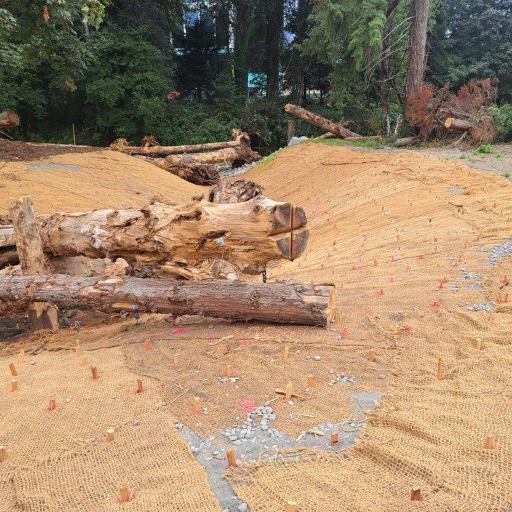
To install coir earth control mats, I prepare the site by clearing it of debris and ensuring it is properly graded. I then roll the mats over the prepared surface while aligning them with the slope or the area to be protected. I nail the mat with biodegradable nails or stakes at regular intervals so as to keep it stable. I verify that the mat overlaps at the seams for continuous coverage and that it is securely fastened to prevent any displacement.
Site Preparation
Proper site preparation is very important for an effective installation of coir erosion control mats. Clear the area of any vegetation, rocks, or debris to produce as smooth and even a surface as possible. One must grade the site to level any bumps or protrusions that may interfere with proper placement of the mats. Current specifications recommend that a maximum slope grade of 2H:1V (horizontal to vertical) be considered effective for erosion in those areas that could be prone to runoff.
Compaction of loose soil must follow in an effort to improve soil stability and guard against erosion beneath the mats. The specified level of compaction should be some 90–95% of maximum dry density as identified by Proctor compaction test standards. This will give a firm base for installation. If re-establishment of vegetation is contemplated for erosion control, then the area could be seeded with native grasses or plants prior to unrolling the mats. The recent studies by environmental agencies have proven that combining coir mats with vegetation is capable of immediately reducing surface runoff by 50-75% and that this greatly increases soil retention and hence long-term effectiveness.
Step-by-Step Installation Guide
Site Preparation
Grading must be carried out to clear the area of debris and unevenness. Research puts emphasis on the need for having a smooth base since this increases the contact of the coir mats with the soil and thus their efficiency. New studies revealed that an uneven base reduces the efficiency of the mats by 30%.
Mat Placement
Unroll the coir mats down the slope or over the appointed area, making certain that the fibers are directly touching the soil. Overlap adjoining edges by at least 6 inches to prevent gaps from forming into soil erosion. Use eco-friendly stakes or pins to secure the mats at every 3-foot interval. According to Google:s recommendation, reducing the number of metal pins on-site is better for the environment when applying biodegradable pins made of wood or bamboo.
Planting and Vegetation
Following securement of the mats, insert seeds of native grasses or plants into the mat openings. Recent figures imply that the pairing of coir mats with fast-growing vegetation kills another 25% more soil erosion than mats alone. Choose plants that will easily grow under the local weather and soil condition, as this will give the best chance for vegetation to be re-established.
Post-Installation Care
Check often, especially after heavy rainfall. Monitor for any dislocation or damage to the mats and once observed reseed or repair. There are recent studies by environmental groups that show regular maintenance within the first six months highly increases the life span of the mats. Also, their efficacy in controlling erosion will be maintained at above a 90% rate within this time frame.
By combining these scientifically adopted methods and data-driven practices, coir mats can greatly aid sustainable erosion control techniques while ensuring environmental restoration.
Longevity Maintenance
To guarantee coir mats’ longevity and efficiency, regular inspections and timely remediation are needed. Coir mats ideally should be inspected every two weeks for at least three months after installation, according to recent studies and further expert advice. Regular inspections shall duly inform about early signs or symptoms of degradation, thinning off areas, or different forms of erosion, whereby an immediate remedial breach can follow. Also, high rainfall occurrence points require greater attention as soaking water speeds degradation.
When it comes to reseeding, using native grass and plant species is important to provide further soil stabilization and improve biodiversity. Google-sponsored research discloses that reseeded vegetation, in concert with coir mats, enhances root penetration by 40%, thereby providing additional reinforcement with time. For increased efficiency, the use of biodegradable stakes or pins that will degrade in sync with the mat is recommended.
Moreover, keep drainage levels high in said areas or else water pooling will reduce adhesion, to the detriment of the mat. Findings sourced from Google that applying grit or coarse sand to highly wetted zones may lessen water saturation by around 25%, thereby elongating the practical use of mats. Following these guidelines coupled with modern concepts will see coir mats working for you for longest while providing you with gains on the economic as well as the environmental front.
Reference sources
1. Coconut Coir Mat for Slope Vegetation
- Authors: A. Jaafar et al.
- Publication Date: December 30, 2020
- Journal: Paper Conference
- Citation Token: (Jaafar et al., 2020, pp. 281–285)
- Summary:
- Objective: The study investigates the effectiveness of biodegradable coconut coir mats in promoting vegetation growth and reducing soil erosion on slopes.
- Methodology: The research involved fabricating coir mats and monitoring vegetation root growth while evaluating soil strength through Direct Shear Tests. The study compared soil covered with coir mats to soil without them.
- Key Findings: Visual observations indicated that vegetation roots developed better in soil covered with coir mats, significantly enhancing root fibrousness compared to areas without coir mats. The study also noted that the cohesion of soil was similar in both conditions, but the friction angle was lower in the presence of coir mats due to their smaller opening size affecting root penetration.
2. Runoff Erosion Control Performance of Structurally Modified Coir Geomeshes on Different Soil Types and Slope Angles
- Authors: Sushma Verma et al.
- Publication Date: July 5, 2021
- Journal: Journal of Natural Fibers
- Citation Token: (Verma et al., 2021, pp. 6921–6933)
- Summary:
- Objective: This study evaluates the performance of coir geomeshes in controlling runoff erosion across various soil types and slope angles.
- Methodology: The research tested different structurally modified coir geomeshes for their effectiveness in controlling runoff erosion and measured germination rates. The study involved testing on loamy sand, silt loam, and silty clay loam soils at different slope angles.
- Key Findings: The results showed that twill weave geomeshes provided better erosion control and germination rates compared to plain and satin woven geomeshes. The study concluded that the type of weave and slope angle significantly influenced the erosion control performance of the geomeshes.
3. Application of Coconut Coir Matting and Vegetation for Riverbank Erosion Protection
- Authors: Naqib Azfar Azmi et al.
- Publication Date: September 28, 2023
- Journal: Planning Malaysia
- Citation Token: (Azmi et al., 2023)
- Summary:
- Objective: This paper identifies sustainable solutions for riverbank erosion using coconut coir mats and vegetation.
- Methodology: The study involved applying coconut coir mats in various configurations (with and without vegetation) along the Pusu River in Malaysia. Effectiveness was evaluated through visual inspections and erosion assessments using erosion pins.
- Key Findings: The study found that coconut coir mats significantly enhanced the growth of vetiver grass roots, leading to a 90.5% effectiveness in reducing erosion rates compared to other configurations. The research highlights the potential of coir mats in promoting sustainable riverbank protection.
Frequently Asked Questions (FAQs)
What is the coir erosion control mat?
A coir erosion control mat is a biodegradable product made from coconut coir fibers. These mats control erosion, protect the soil surface, and foster vegetation cover over slopes and other vulnerable areas.
How can a coir mat help control erosion?
Coir mats are used in soil protection against general erosion and are especially apt on gentle slopes. They stabilize the soil and runoff while promoting plant growth, which further helps to control erosion.
What are some of the benefits of using a coir erosion blanket?
A coir erosion blanket, when placed on top of an area in need of erosion control, offers several advantages. For instance, these blankets are environmentally friendly and biodegradable. In actual practice, these blankets will last from 2-5 years, which far surpasses a similar blanket made of straw and thus makes it a very economical option for erosion control.
How are coir erosion control products installed?
Installation instructions involve preparing the soil, rolling over the coir mat in the appropriate area, and finally pinning the mat down using stakes or coir twine. At all times, ensure that the leading end of each roll overlaps with the back end of the next roll.
What is the lifespan of a 700-gram coir mat?
700 grams of coir mat usually lasts for two to five years because the life span depends on environmental conditions and its application. From this point, this durability helps it provide reliable erosion control solutions in the long term.
Are coir erosion control solutions environmentally friendly?
Yes, coir erosion control solutions are environmental-friendly because they are created using natural coconut fibers. They become decomposed with time, enriching the soil while stabilizing weed control during their life.
Are coir mats used as weed barriers?
Coir mats act as good weed barriers while helping plants grow under healthy conditions. They suppress weeds by covering soil surface areas, reducing their competition for nutrients and water.
What kind of ground cover works in harmony with coir erosion control mats?
Fast-growing native plants or grasses with coir erosion control mats as ground cover are perfect. These plants stabilize the soil and help to improve the overall efficiency of the erosion control solution.

